Recent Posts
Tips to Protect Your Home from Fire Damage in Salt Lake City, UT
7/19/2024 (Permalink)
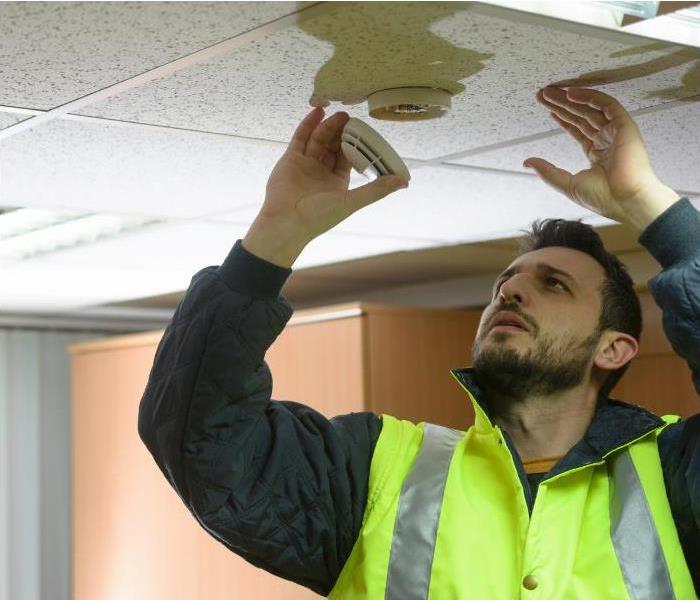 Safeguard Your Salt Lake City Home from Fire Damage
Safeguard Your Salt Lake City Home from Fire Damage
Living in Salt Lake City offers a picturesque view of the Wasatch Mountains and a vibrant urban life. However, with its unique climate and landscape, homeowners in this area must be particularly vigilant about fire safety. Protecting your home from fire damage is crucial to ensuring the safety of your family and property. Here are some essential tips to safeguard your home from the threat of fire.
1. Install Smoke Alarms
Smoke alarms are your first line of defense against fires. They provide early warning, allowing you and your family to evacuate safely and call for help. Here are some key points to consider:
Install smoke alarms on every level of your home: Place them inside bedrooms and outside sleeping areas to ensure you hear the alarm even if you’re asleep.
Test alarms monthly: Regularly check that your smoke alarms are functioning correctly. Replace batteries at least once a year, and consider using alarms with a long-life lithium battery.
Replace alarms every 10 years: Smoke alarms lose their sensitivity over time. Ensure your alarms are up-to-date to maintain optimal protection.
2. Create and Practice a Fire Escape Plan
In the event of a fire, every second counts. Having a well-rehearsed fire escape plan can save lives:
Develop a clear plan: Outline two escape routes from each room and establish a meeting point outside the home.
Practice regularly: Conduct fire drills with your family at least twice a year to ensure everyone knows the plan.
Teach children how to escape: Make sure children understand the plan and know how to respond if they hear the smoke alarm.
3. Maintain Your Electrical System
Faulty electrical systems are a common cause of house fires. Regular maintenance and safe practices can prevent electrical fires:
Inspect wiring: Have a licensed electrician inspect your home’s wiring periodically, especially if your home is older.
Avoid overloading outlets: Plugging too many devices into a single outlet can cause overheating and fires. Use power strips with surge protectors and avoid daisy-chaining extension cords.
Unplug unused appliances: Unplugging appliances when they’re not in use can prevent overheating and potential fires.
4. Be Cautious with Heating Equipment
Salt Lake City winters can be cold, necessitating the use of heating equipment. However, heaters and fireplaces can be fire hazards if not used properly:
Keep flammable objects away: Maintain a safe distance between heating equipment and flammable materials like furniture, curtains, and paper.
Inspect and clean chimneys: Have your chimney inspected and cleaned annually to prevent creosote buildup, which can ignite and cause a fire.
Use space heaters safely: Follow manufacturer instructions, keep them on a stable surface, and turn them off before leaving the room or going to bed.
5. Cook with Care
The kitchen is a common area for house fires to start. Practicing safe cooking habits can significantly reduce this risk:
Never leave cooking unattended: Stay in the kitchen while you’re cooking, especially when using high heat or frying.
Keep flammable objects away from the stove: Ensure dish towels, paper towels, and other flammable items are kept away from the stovetop.
Install a fire extinguisher: Keep a multi-purpose fire extinguisher in the kitchen and ensure you know how to use it.
6. Practice Safe Smoking Habits
Smoking is a leading cause of house fires. If you smoke, follow these guidelines to reduce the risk:
Smoke outside: Avoid smoking indoors to prevent accidental fires.
Use deep, sturdy ashtrays: Ensure cigarettes are fully extinguished by using appropriate ashtrays.
Never smoke in bed: Falling asleep while smoking is extremely dangerous and can easily lead to a fire.
7. Store Flammable Materials Safely
Many common household items are flammable and need to be stored safely to prevent fires:
Keep flammable liquids in a cool, dry place: Store gasoline, paint, and other flammable liquids away from heat sources and in proper containers.
Limit the use of candles: Use battery-operated candles instead of open-flame candles, especially if you have pets or small children.
Properly dispose of oily rags: Oily rags can spontaneously combust. Store them in a metal container with a tight lid and dispose of them properly.
8. Use Fire-Resistant Building Materials
If you’re building or renovating your home, consider using fire-resistant materials to enhance your home’s safety:
Fire-resistant roofing: Choose roofing materials such as metal, tile, or asphalt shingles that are designed to resist fire.
Fire-rated doors and windows: Install fire-rated doors and windows to slow the spread of fire and provide additional escape time.
Non-combustible siding: Materials like brick, stucco, or fiber-cement siding can help prevent fires from spreading to your home.
9. Create a Defensible Space
Creating a defensible space around your home can reduce the risk of fire spreading to your property:
Clear vegetation: Remove dead plants, leaves, and other flammable materials from around your home.
Maintain landscaping: Keep trees and shrubs well-trimmed and away from your house.
Use fire-resistant plants: Consider landscaping with fire-resistant plants and materials.
10. Stay Informed and Prepared
Staying informed about fire risks and being prepared can make all the difference:
Monitor weather conditions: Be aware of high fire danger days and take extra precautions during these times.
Keep emergency contacts handy: Have a list of emergency contacts, including local fire departments and neighbors, readily available.
Prepare an emergency kit: Keep an emergency kit with essentials like water, food, medications, and important documents in case you need to evacuate.
Protecting your home from fire damage in Salt Lake City requires vigilance and proactive measures. By installing smoke alarms, creating a fire escape plan, maintaining your electrical and heating systems, practicing safe cooking and smoking habits, storing flammable materials safely, using fire-resistant building materials, creating a defensible space, and staying informed, you can significantly reduce the risk of fire. Taking these steps not only safeguards your property but also ensures the safety and well-being of your loved ones.
Protecting Your Home and Community: Fire Risks in Salt Lake City, Utah, and How to Mitigate Them
7/5/2024 (Permalink)
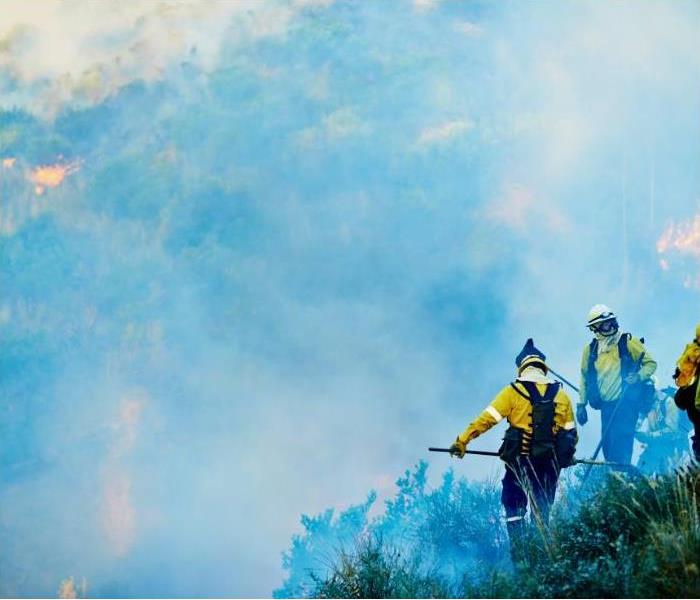 Fire Risks in Salt Lake City, Utah
Fire Risks in Salt Lake City, Utah
Nestled against the backdrop of the stunning Wasatch Range, Salt Lake City, Utah, boasts natural beauty that captivates residents and visitors alike. However, this picturesque setting also comes with its share of challenges, one of the most significant being the risk of wildfires. As climate change intensifies, the threat of wildfires in Utah and across the western United States has become more prominent. This blog aims to raise awareness about fire risks in Salt Lake City and provide practical tips on how residents can protect their homes and communities.
1. Understanding Fire Risks in Salt Lake City:
Salt Lake City and its surrounding areas are not immune to the dangers of wildfires, especially during the dry summer months. Utah's diverse landscapes, ranging from lush forests to arid foothills, create an environment where fires can spread quickly and devastate communities. Human activities, such as campfires, discarded cigarettes, and even sparks from equipment, contribute to the ignition of wildfires.
2. Factors contributing to fire risks in Salt Lake City:
Climate Conditions:
The semi-arid climate in Salt Lake City means that the region experiences hot and dry conditions, especially in the summer. Prolonged periods of drought increase the likelihood of vegetation becoming highly flammable, providing fuel for wildfires.
Wildland-Urban Interface:
Many residential areas in Salt Lake City are situated in close proximity to natural vegetation, creating a wildland-urban interface. This proximity increases the risk of wildfires spreading from forests or grasslands to residential areas.
Wind Patterns:
The geography of Salt Lake City, with its valleys and mountain ranges, can create wind patterns that facilitate the rapid spread of wildfires. High winds can carry embers over long distances, igniting new fires and making containment efforts challenging.
3. Mitigating Fire Risks:
Create Defensible Space:
Homeowners can take proactive steps to create defensible space around their properties. This involves removing combustible materials, such as dead vegetation, leaves, and branches, within a certain radius of the home. Additionally, maintaining a safe distance between trees and structures can help prevent the spread of fires.
Fire-Resistant Landscaping:
Choosing fire-resistant plants for landscaping can be a crucial step in reducing the risk of wildfires. Opt for plants with high moisture content and low flammability, and maintain a defensible space by regularly pruning vegetation.
Building with Fire-Resistant Materials:
When constructing or renovating homes, using fire-resistant materials can provide an added layer of protection. Materials such as Class A fire-rated roofing, tempered glass windows, and non-combustible siding can help prevent the spread of flames.
Clearing Gutters and Roofs:
Regularly clearing gutters and roofs of debris, such as leaves and pine needles, can prevent the accumulation of flammable materials. Embers from a nearby wildfire can easily ignite accumulated debris on roofs, posing a significant threat to homes.
Embrace Fire-Smart Practices:
Educating the community about fire-smart practices is essential. This includes promoting responsible campfire use, discouraging the use of fireworks in high-risk areas, and ensuring proper disposal of cigarette butts.
4. Community Engagement and Preparedness:
Emergency Preparedness Plans:
Communities in Salt Lake City should develop and implement emergency preparedness plans. This includes establishing evacuation routes, organizing community drills, and ensuring that residents are aware of emergency procedures.
Community Cleanup Events:
Regular community cleanup events can help reduce the risk of wildfires by clearing common areas of combustible materials. This collaborative effort fosters a sense of shared responsibility and strengthens community resilience.
Reporting Suspicious Activities:
Encouraging residents to report suspicious activities, such as illegal burning or reckless behavior, can help authorities address potential fire hazards before they escalate.
Firebreaks and Controlled Burns:
Authorities can create firebreaks – cleared areas that act as barriers to slow or stop the progress of a wildfire. Additionally, controlled burns, when safely executed, can reduce excess vegetation and mitigate the risk of uncontrolled wildfires.
In conclusion, as residents of Salt Lake City, Utah, bask in the beauty of their surroundings, it's crucial to remain vigilant against the ever-present threat of wildfires. By understanding the factors that contribute to fire risks and taking proactive measures to mitigate them, individuals and communities can play a pivotal role in safeguarding their homes and the natural landscapes they cherish. Through a combination of responsible land management, fire-resistant building practices, and community engagement, Salt Lake City can enhance its resilience in the face of wildfire challenges, ensuring the safety and well-being of its residents for generations to come.
Storm Damage Remediation Steps in Salt Lake City, UT: A Comprehensive Guide
7/3/2024 (Permalink)
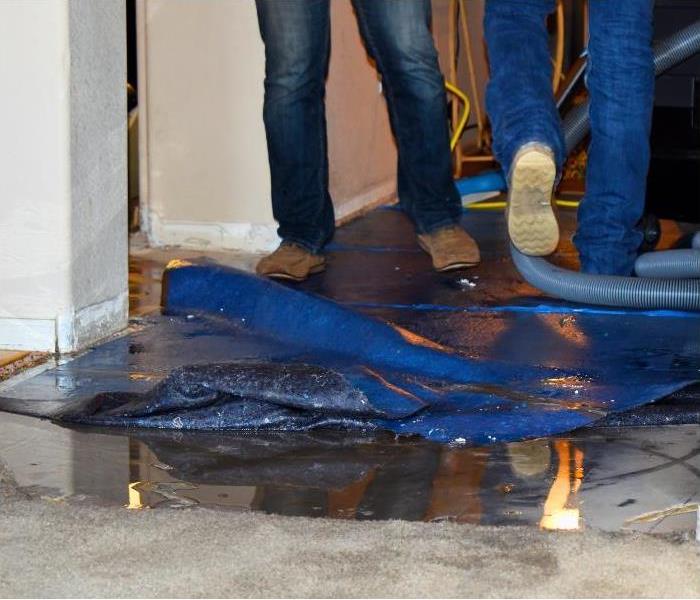 Storm Damage Remediation in Salt Lake City, UT
Storm Damage Remediation in Salt Lake City, UT
Salt Lake City, nestled against the picturesque backdrop of the Wasatch Mountains, enjoys its fair share of natural beauty and outdoor activities. However, like many places, it is also susceptible to severe weather events, including storms that can wreak havoc on homes and properties. From heavy rains to fierce winds and occasional snowstorms, these weather patterns can lead to significant damage, requiring prompt and effective remediation efforts.
1. Understanding Storm Damage
Storm damage in Salt Lake City can take various forms depending on the season and the severity of the weather event. Common types of storm damage include:
Roof Damage: High winds and heavy precipitation can cause shingle damage, leaks, or even structural issues to roofs.
Water Damage: Flooding from heavy rains or snowmelt can infiltrate homes, causing damage to walls, floors, and belongings.
Tree Damage: Falling branches or uprooted trees can damage roofs, windows, and siding.
Siding and Window Damage: Strong winds can impact siding and windows, leading to cracks, breaks, or complete detachment.
Foundation Issues: Excessive rain or snowmelt can saturate the soil around foundations, potentially causing shifts or cracks.
2. Immediate Steps After a Storm
When a storm hits Salt Lake City and damages your property, taking immediate action is crucial to mitigate further harm and begin the remediation process:
Safety First: Ensure everyone's safety. If there are any immediate hazards such as downed power lines or structural instability, evacuate the premises and contact emergency services.
Assess Damage: Conduct a thorough inspection of your property to assess the extent of the damage. Document everything for insurance purposes, including taking photos or videos if possible.
Temporary Repairs: If safe to do so, undertake temporary repairs to prevent further damage. This could include tarping a damaged roof, boarding up broken windows, or drying out waterlogged areas.
Contact Your Insurance Provider: Notify your insurance company as soon as possible to begin the claims process. Provide them with detailed documentation and keep records of all communications.
3. Steps for Storm Damage Remediation
Once the initial steps are completed, the process of storm damage remediation in Salt Lake City typically involves several key phases:
1. Water Damage Restoration
If your home has suffered from flooding or water infiltration:
Water Extraction: Use pumps and vacuums to remove standing water from affected areas.
Drying and Dehumidification: Employ industrial-grade dehumidifiers and air movers to thoroughly dry out walls, floors, and carpets.
Mold Prevention: Treat potential mold growth areas with antimicrobial solutions to prevent mold and mildew formation.
2. Roof and Structural Repairs
Addressing roof and structural damage is crucial for ensuring the integrity of your home:
Roof Inspection and Repair: Hire qualified professionals to inspect and repair roof damage. This may involve replacing missing shingles, repairing leaks, or even replacing sections of the roof if necessary.
Structural Assessment: Check for any structural damage to walls, ceilings, or foundations. Reinforce or repair as needed to maintain stability.
3. Siding, Window, and Exterior Repairs
Repair or replace damaged siding, windows, and other exterior components:
Siding Replacement: Replace cracked or detached siding panels to restore insulation and aesthetic appeal.
Window Repair or Replacement: Repair broken windows or replace them with energy-efficient alternatives.
Exterior Inspection: Conduct a thorough inspection of exterior walls and surfaces for hidden damage that could lead to future issues.
4. Landscape and Tree Care
Address any landscaping issues and remove hazards posed by fallen trees or branches:
Tree Removal: Safely remove fallen trees or branches that pose a risk to structures or safety.
Landscape Restoration: Repair landscaping features such as gardens, fences, or pathways damaged during the storm.
5. Final Inspections and Documentation
Once remediation efforts are complete, perform final inspections to ensure all repairs meet safety and quality standards:
Quality Assurance: Verify that all repairs and replacements have been completed to your satisfaction.
Documentation: Keep detailed records of all repairs, receipts, and communications with contractors and insurance providers for future reference.
Navigating storm damage remediation in Salt Lake City requires a proactive approach, attention to safety, and timely coordination with professionals and insurance providers. By following these comprehensive steps, homeowners can effectively restore their properties and minimize the long-term impact of severe weather events. Remember, prompt action and thorough documentation are key to a successful recovery from storm damage.
5 Essential Tips to Mitigate Flood Risks in Salt Lake City, UT
5/18/2024 (Permalink)
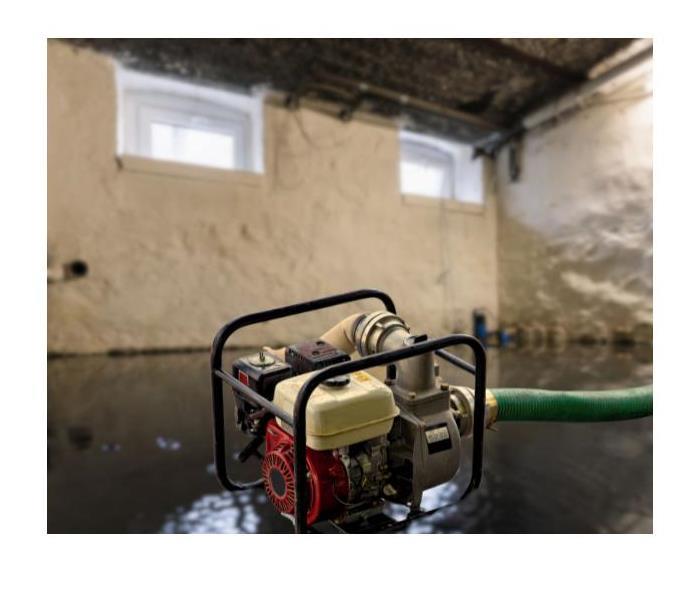 Mitigate Flood Risks in Salt Lake City, UT
Mitigate Flood Risks in Salt Lake City, UT
Salt Lake City, Utah, nestled against the majestic backdrop of the Wasatch Mountains, is not immune to the threat of flooding. With its unique geography and occasional severe weather patterns, the city faces the potential for devastating floods. However, with proactive measures and community involvement, the risks can be significantly reduced. In this blog, we'll explore five crucial tips to mitigate flood risks in Salt Lake City.
1. Understand Your Flood Risk:
Knowledge is power when it comes to flood preparedness. Begin by understanding your property's flood risk. The Federal Emergency Management Agency (FEMA) provides flood maps that delineate areas prone to flooding, known as Special Flood Hazard Areas (SFHAs), and the degree of risk in those areas. By accessing these maps, residents can assess their vulnerability and take appropriate action. Additionally, local authorities often offer flood risk assessment tools and resources to help residents better understand their exposure.
2. Invest in Flood Insurance:
One of the most effective ways to safeguard your home and belongings against flood damage is by investing in flood insurance. Many homeowners mistakenly assume that their standard homeowner's insurance policy covers flood damage, only to find out too late that it does not. In Salt Lake City, where flash floods and heavy rainfall can occur, having flood insurance is essential for financial protection. The National Flood Insurance Program (NFIP) provides coverage for homeowners, renters, and businesses in participating communities. While it may seem like an additional expense, the peace of mind and financial security it offers in the event of a flood are invaluable.
3. Maintain Your Property:
Regular maintenance of your property can help mitigate flood risks and minimize potential damage. Keep gutters and downspouts clear of debris to ensure proper drainage away from your home's foundation. Grade your yard away from the building to prevent water from pooling around the structure. Inspect and maintain your sump pump to ensure it is functioning correctly during heavy rainfall. Consider installing backflow valves to prevent sewage backup into your home during flooding. By staying proactive with property maintenance, you can reduce the likelihood of flood-related issues.
4. Implement Floodproofing Measures:
Floodproofing involves retrofitting your home to minimize flood damage and increase its resilience to flooding. There are several floodproofing techniques that homeowners in Salt Lake City can consider, depending on their property's specific needs and vulnerabilities. Elevating electrical systems, appliances, and HVAC equipment above potential flood levels can prevent costly damage and reduce safety hazards. Installing flood barriers, such as sandbags or flood gates, can help divert water away from your property or create barriers to protect vulnerable entry points. Additionally, sealing walls, floors, and openings with waterproofing materials can help prevent water intrusion during a flood event.
5. Engage in Community Preparedness Efforts:
Flood preparedness is not solely the responsibility of individual homeowners; it requires community-wide collaboration and coordination. Get involved in local flood preparedness efforts by participating in community meetings, volunteering with emergency response organizations, or joining neighborhood flood mitigation initiatives. Stay informed about emergency evacuation routes, shelters, and communication channels in the event of a flood emergency. Encourage your neighbors to take proactive measures to reduce flood risks, such as proper drainage maintenance and flood insurance coverage. By working together as a community, Salt Lake City residents can enhance their collective resilience to flooding.
In Salt Lake City, as in any flood-prone area, taking proactive steps to mitigate flood risks is essential for safeguarding lives, property, and livelihoods. By understanding flood risks, investing in flood insurance, maintaining properties, implementing floodproofing measures, and engaging in community preparedness efforts, residents can significantly reduce their vulnerability to flooding. While it's impossible to completely eliminate the threat of flooding, these tips can help residents better prepare, respond, and recover from flood events, ensuring a more resilient and secure future for Salt Lake City.
Refresh Your Home: Essential Spring Cleaning Tips for Salt Lake City Residents
4/10/2024 (Permalink)
 Spring Cleaning in Downtown Salt Lake City, UT.
Spring Cleaning in Downtown Salt Lake City, UT.
Spring has sprung, and it's time to shake off the winter blues and breathe new life into your home! As the snow melts away in Salt Lake City, UT, there's no better time to embark on the age-old tradition of spring cleaning. Whether you're a seasoned cleaner or a novice looking to spruce up your space, these essential tips will help you tackle the task efficiently and effectively.
1. Create a Plan of Attack:
Before diving into the cleaning frenzy, take a moment to strategize. Assess which areas of your home need the most attention and prioritize tasks accordingly. Breaking down the cleaning process room by room can help you stay organized and prevent overwhelm.
2. Declutter First:
Spring cleaning provides the perfect opportunity to declutter and streamline your belongings. Start by sorting through items and deciding what to keep, donate, or discard. Remember, less clutter means less to clean!
3. Dust from Top to Bottom:
Dust accumulates quickly, especially after a long winter. Grab a microfiber cloth or duster and work your way from ceiling to floor, tackling shelves, light fixtures, and furniture along the way. Don't forget to dust ceiling fans and baseboards, as these often overlooked areas harbor plenty of dust and allergens.
4. Deep Clean Carpets and Upholstery:
Salt Lake City's snowy winters can take a toll on carpets and upholstery, trapping dirt, moisture, and allergens. Consider renting a carpet cleaner or hiring a professional service to give your carpets and upholstery a deep clean. Not only will this improve the appearance of your home, but it will also promote a healthier indoor environment.
5. Freshen Up Window Treatments:
Winter weather can leave window treatments looking dull and dusty. Take down curtains, blinds, or shades and launder or dust them according to the manufacturer's instructions. While they're off the windows, take the opportunity to clean the windowpanes inside and out for a streak-free shine.
6. Tackle the Kitchen:
The kitchen is often the heart of the home, but it can also be a breeding ground for grime and grease. Start by cleaning out the refrigerator and pantry, disposing of expired items and wiping down shelves. Scrub countertops, backsplashes, and appliances, paying special attention to areas prone to spills and splatters. Don't forget to clean out the oven and microwave for a fresh start to the season.
7. Revitalize Outdoor Spaces:
Salt Lake City residents love spending time outdoors, especially when the weather warms up. Take some time to spruce up your outdoor spaces by sweeping away debris, power washing surfaces, and refreshing outdoor furniture. Consider planting some seasonal flowers or herbs to add a pop of color and fragrance to your patio or garden.
8. Refresh Bedding and Linens:
After a long winter, there's nothing quite like crawling into fresh, clean sheets. Strip the beds and launder all bedding, including sheets, pillowcases, and duvet covers. While you're at it, don't forget to wash or dry-clean curtains, pillow shams, and decorative throws for a complete bedroom refresh.
9. Organize and Cleanse the Garage:
For many Salt Lake City residents, the garage serves as a catch-all for outdoor gear, tools, and seasonal decorations. Take advantage of spring cleaning to declutter and organize this space. Invest in storage solutions such as shelves, bins, and hooks to keep items off the floor and easily accessible. Sweep out dirt and debris, and consider giving the garage floor a good scrub to remove oil stains and grime.
10. Don't Forget About HVAC Maintenance:
As temperatures rise in Salt Lake City, your HVAC system will be working overtime to keep your home comfortable. Schedule a professional inspection and maintenance service to ensure that your heating and cooling systems are running efficiently. Replace air filters as needed to improve indoor air quality and prevent dust and allergens from circulating throughout your home.
11. Safety First:
Lastly, spring cleaning is also an excellent time to check and replace batteries in smoke detectors and carbon monoxide detectors. Test these devices to ensure they are functioning correctly and provide peace of mind for you and your family.
Spring cleaning may seem like a daunting task, but with the right approach and a little elbow grease, you can transform your home into a clean and inviting sanctuary. By following these essential tips, Salt Lake City residents can bid farewell to winter and embrace the fresh beginnings that spring has to offer. So roll up your sleeves, put on some upbeat music, and get ready to welcome the season with a clean and refreshed home!
How to Identify a Mold Problem in Your Salt Lake City, UT Home
3/11/2024 (Permalink)
 Identifying a mold problem in Downtown Salt Lake City, UT
Identifying a mold problem in Downtown Salt Lake City, UT
Mold is a common issue that homeowners may face, and its presence can have detrimental effects on both the structure of your home and your health. Living in Salt Lake City, UT, with its unique climate and environmental conditions, makes it crucial for residents to be vigilant about mold prevention and detection. In this blog post, we will explore the signs of a potential mold problem, the factors contributing to mold growth in Salt Lake City, and effective ways to address and prevent mold issues in your home.
Understanding Mold in Salt Lake City
Salt Lake City experiences a semi-arid climate with hot summers and cold winters. This unique climate, coupled with occasional humidity, can create an environment conducive to mold growth. Mold thrives in damp and dark conditions, making basements, bathrooms, and attics susceptible areas in homes. Understanding the factors that contribute to mold growth in Salt Lake City is the first step in identifying and preventing the problem.
Signs of a Mold Problem
Visible Mold Growth: One of the most obvious signs of a mold issue is the presence of visible mold growth. Mold can appear in various colors, including black, green, or brown, and may resemble spots or patches on surfaces.
Musty Odor: Mold often produces a distinct musty odor. If you notice a persistent and unpleasant smell in your home, especially in areas with poor ventilation, it could be an indication of hidden mold growth.
Water Damage: Salt Lake City residents may face water-related issues due to heavy snowfall and occasional rain. Water damage, whether from leaks, flooding, or high humidity, creates an ideal environment for mold to thrive. Be vigilant about addressing water damage promptly to prevent mold growth.
Peeling Paint or Discoloration: Mold can cause paint to peel or surfaces to discolor. Pay attention to any changes in the appearance of walls, ceilings, or other surfaces, as these could be indicative of an underlying mold problem.
Preventing Mold Growth
Control Indoor Humidity: Given Salt Lake City's climate, it's crucial to control indoor humidity levels. Use dehumidifiers in damp areas, ensure proper ventilation, and promptly address any leaks or water damage to prevent the conditions that mold thrives in.
Proper Ventilation: Ensure proper ventilation in areas prone to moisture, such as bathrooms, kitchens, and basements. Use exhaust fans, open windows when possible, and consider installing ventilation systems to promote air circulation.
Regular Inspections: Conduct regular inspections of your home, especially in areas where mold is likely to grow. Check for leaks, water damage, and signs of mold growth. Early detection can help prevent extensive damage and mitigate potential issues.
Address Water Damage Promptly: Whether it's a leaky roof, a burst pipe, or flooding, address water damage promptly. Dry and clean affected areas thoroughly, and consider consulting professionals for extensive water damage restoration to prevent mold growth.
Use Mold-Resistant Products: When renovating or building, consider using mold-resistant materials. Mold-resistant drywall, paints, and insulation can help create an environment less conducive to mold growth.
Identifying and addressing mold problems in your Salt Lake City home is crucial for the well-being of your family and the longevity of your property. By understanding the signs of mold growth and implementing proactive measures, you can create a mold-resistant living environment. Regular maintenance, prompt response to water damage, and proper ventilation are key factors in preventing mold issues. If you suspect a significant mold problem, it's advisable to seek professional assistance to ensure thorough remediation and a safe living space. Taking these steps will contribute to a mold-free home in Salt Lake City, allowing you to enjoy the beauty of the city without the worry of hidden mold hazards.
Navigating Water Damage: A Comprehensive Guide to Restoration with SERVPRO of Downtown Salt Lake City/Team Grimstead
1/15/2024 (Permalink)
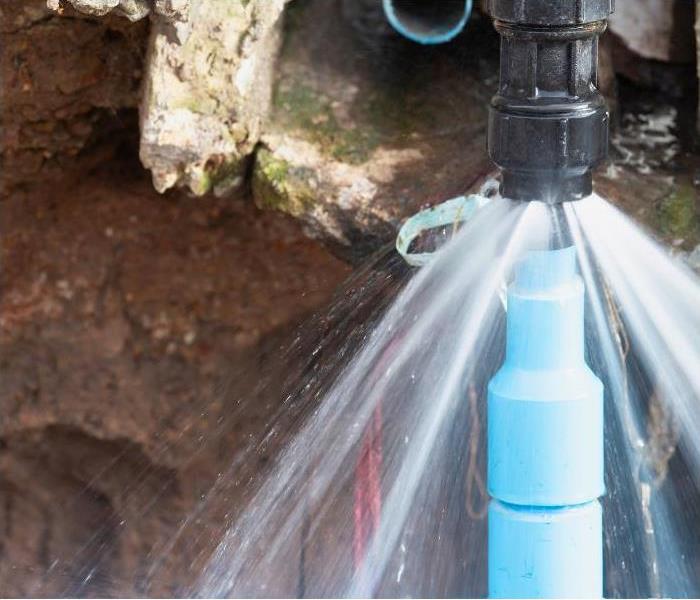 Burst Pipe in Downtown Salt Lake City, UT.
Burst Pipe in Downtown Salt Lake City, UT.
Water damage is a homeowner's nightmare that can strike at any time, leaving a trail of destruction in its wake. From burst pipes to severe storms, the consequences of water damage can be overwhelming. Fortunately, professional restoration services like SERVPRO of Downtown Salt Lake City/Team Grimstead are here to help you navigate the turbulent waters of water damage and restore your home to its former glory.
9 Steps to Restoration with SERVPRO of Downtown Salt Lake City/Team Grimstead
1. Understanding the Impact of Water Damage:
Water damage can manifest in various forms, ranging from visible water stains and warped floorboards to more severe structural issues. The initial moments after discovering water damage are crucial; it's essential to act swiftly to minimize the potential for long-term damage. Ignoring water damage or attempting to handle it without professional assistance can lead to more significant issues, such as mold growth and compromised structural integrity.
2. The Role of SERVPRO of Downtown Salt Lake City/Team Grimstead:
SERVPRO of Downtown Salt Lake City/Team Grimstead is a reputable water damage restoration company known for its expertise in mitigating and repairing water-related issues. With a team of highly trained professionals and state-of-the-art equipment, they are well-equipped to handle water damage of any scale.
3. Assessment and Inspection:
The first step in the restoration process is a thorough assessment and inspection of the affected areas. SERVPRO's skilled technicians will identify the source of the water damage, assess the extent of the damage, and formulate a comprehensive plan for restoration. This meticulous approach ensures that no detail is overlooked, allowing for a more accurate and effective restoration process.
4. Water Extraction:
Once the assessment is complete, the next step is water extraction. Using powerful pumps and vacuums, SERVPRO of Downtown Salt Lake City/Team Grimstead will efficiently remove standing water from your property. This step is crucial in preventing further damage and creating a clean slate for the restoration process.
5. Drying and Dehumidification:
After water extraction, the affected areas need to be thoroughly dried to prevent mold growth and other secondary issues. SERVPRO employs advanced drying and dehumidification techniques to expedite the process, ensuring that your home is returned to a safe and dry condition promptly.
6. Restoration and Reconstruction:
With the water removed and the affected areas dried, the restoration process begins. This may involve repairing or replacing damaged materials, such as drywall, flooring, and insulation. SERVPRO of Downtown Salt Lake City/Team Grimstead prides itself on its ability to handle both minor repairs and extensive reconstruction, providing a comprehensive solution to water damage restoration.
7. Mold Remediation:
One of the significant risks associated with water damage is the potential for mold growth. SERVPRO understands the importance of addressing this issue promptly and effectively. Their team employs industry-approved mold remediation techniques to eliminate mold colonies and prevent future growth, ensuring a healthier living environment for you and your family.
8. Working with Your Insurance:
Dealing with water damage can be a stressful experience, but SERVPRO of Downtown Salt Lake City/Team Grimstead aims to make the process as seamless as possible. They work closely with insurance companies, providing documentation and communication to streamline the claims process. This commitment to transparency and efficiency helps alleviate the burden on homeowners during a challenging time.
9. Preventing Future Water Damage:
While SERVPRO of Downtown Salt Lake City/Team Grimstead excels in restoring homes after water damage, they also emphasize the importance of preventive measures. By addressing potential issues such as leaky roofs, faulty plumbing, or inadequate drainage, homeowners can reduce the risk of water damage in the first place. Regular maintenance and timely repairs can go a long way in safeguarding your home against the destructive forces of water.
Water damage is a formidable foe that requires swift and professional intervention. When faced with the aftermath of a water-related disaster, SERVPRO of Downtown Salt Lake City/Team Grimstead stands ready to provide the expertise and support needed to restore your home. From the initial assessment to the final touches of reconstruction, their dedicated team ensures a thorough and effective restoration process. By entrusting your water damage restoration to SERVPRO, you can confidently navigate the challenges and emerge with a revitalized and resilient home.
Water Damage Restoration in Downtown Salt Lake City, Utah: Protecting Properties and Restoring Peace
12/28/2023 (Permalink)
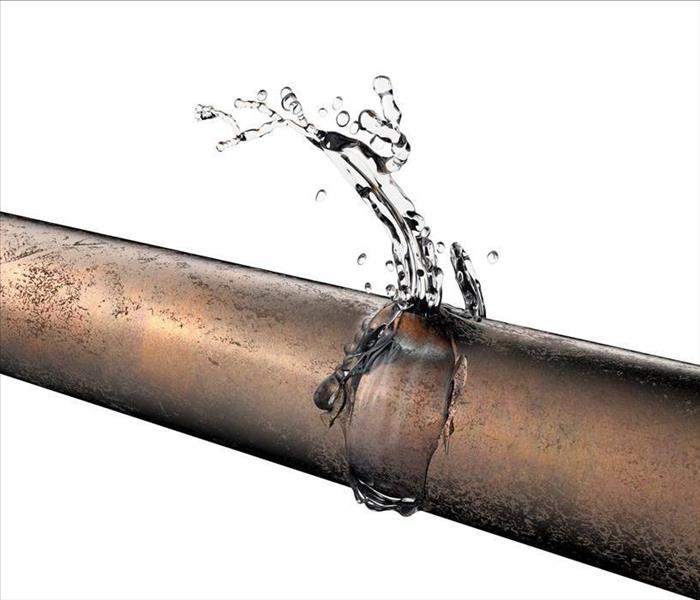 Bursted pipe in Downtown Salt Lake City, UT.
Bursted pipe in Downtown Salt Lake City, UT.
Water damage can wreak havoc on homes and businesses, causing significant financial losses and emotional distress. In Downtown Salt Lake City, Utah, where water-related issues such as floods, pipe bursts, and heavy snowfall are not uncommon, the need for prompt and efficient water damage restoration services is paramount. This blog aims to shed light on the importance of water damage restoration in Downtown Salt Lake City and highlight the key steps involved in the restoration process.
The Threat of Water Damage
Downtown Salt Lake City is not immune to water-related disasters. Whether it's due to natural calamities like flash floods or man-made incidents such as plumbing failures, water damage can occur suddenly and severely impact properties. Excess water can seep into walls, floors, and furniture, leading to structural damage, mold growth, and the potential loss of valuable belongings. It is vital for residents and business owners to be prepared for such situations by understanding the significance of water damage restoration and its role in minimizing the consequences.
Professional Water Damage Restoration Services
When facing water damage, it is essential to engage the services of professional water damage restoration companies in Downtown Salt Lake City. These experts possess the knowledge, experience, and equipment necessary to effectively address water-related issues and restore properties to their pre-damaged condition. From initial assessment and water extraction to drying, dehumidification, and sanitization, these professionals follow a systematic approach to ensure thorough restoration.
- Assessment and Mitigation
Upon arrival at the affected property, water damage restoration experts assess the extent of the damage and formulate a comprehensive mitigation plan. They identify the source of the water intrusion and take immediate steps to stop further damage. By inspecting the affected areas and employing specialized tools such as moisture meters and infrared cameras, professionals can accurately determine the severity of the damage and devise an appropriate restoration strategy.
- Water Extraction and Drying
The first step in the restoration process involves extracting standing water from the property. Professionals utilize high-powered pumps, vacuums, and other advanced equipment to remove water quickly and efficiently. Once the excess water is eliminated, they proceed with drying the affected areas using industrial-grade dehumidifiers, air movers, and specialized drying techniques. This step prevents further damage and minimizes the risk of mold growth.
- Cleaning, Sanitization, and Restoration
After the property is thoroughly dried, the next phase focuses on cleaning and sanitization. Water damage restoration professionals employ antimicrobial treatments to eliminate any potential contaminants and prevent the growth of mold and bacteria. They also clean and restore damaged belongings, ensuring that the property is safe and habitable once again. Additionally, these experts provide assistance in filing insurance claims to help property owners navigate the process smoothly.
Prevention and Preparedness
While water damage restoration is crucial in the aftermath of an incident, taking preventive measures and being prepared can significantly reduce the impact of water-related disasters. Regular inspection and maintenance of plumbing systems, proper drainage management, and installation of flood detection systems are some proactive steps that can minimize the risk of water damage. Furthermore, having a reliable water damage restoration company's contact information on hand ensures prompt response and efficient restoration when emergencies arise.
Water damage restoration is an essential service for the residents and businesses of Downtown Salt Lake City, Utah. By engaging professional restoration companies, property owners can mitigate the devastating effects of water damage, protect their investments, and restore peace of mind. Proactive prevention and preparedness measures further strengthen resilience against water-related disasters. With their expertise and comprehensive restoration process, professionals in Downtown Salt Lake City play a vital role in helping communities recover from water damage and emerge stronger than before.
How to Handle Frozen Pipes
12/28/2023 (Permalink)
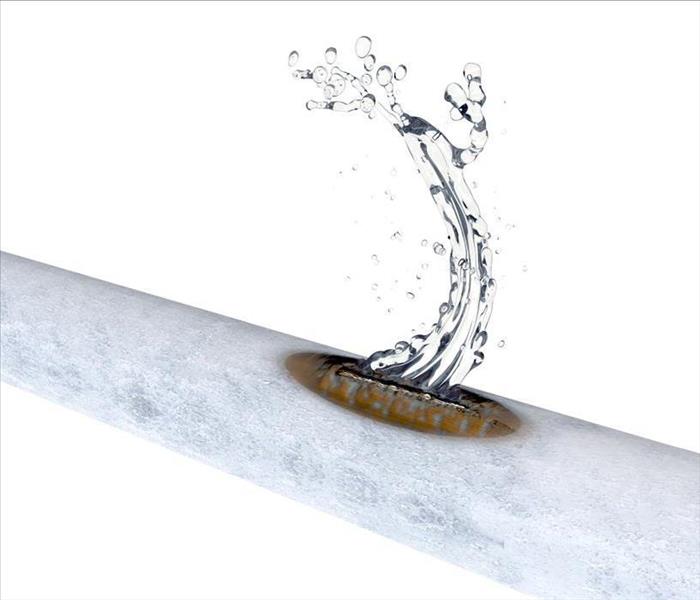 A frozen pipe in Downtown Salt Lake City, UT.
A frozen pipe in Downtown Salt Lake City, UT.
Running water is a necessity in every home, but a busted pipe can easily become a nuisance rather than a convenience. Every homeowner in Downtown Salt Lake City, UT, should know how to handle a frozen pipe and some basic pipe freeze prevention tips.
3 Tips To Consider As Regards Frozen Pipes
1. Frozen Pipe Assessment
If the water from a faucet only comes out in a slow drip when it's turned on, this is a common sign that you have frozen pipes. To locate the source of the problem without exacerbating it, you need to follow several steps:
- Turn off water flow to the pipe that feeds the faucet.
- Open the faucet.
- Trace the path of the pipes leading from the faucet.
- Look for ice, bulges or breaks.
The location of the freeze determines your next move. If the pipe itself is already damaged, you will need a plumber to repair it before you turn the water back on. A layer of frost or ice on intact pipes can usually be melted to save them. Use a hair dryer or portable heater to warm the area around the pipe.
If the pipe is inside the wall, you can turn up the heat in your home, but unless the wall is open, you don't really know what's going on behind it. It's best to hire a professional to find out before you let it fill with water again.
2. Pipe Freeze Prevention
It's good to know how to handle a frozen pipe. The best solution, however, is to keep it from frosting over in the first place. A few pipe freeze prevention strategies can go a long way toward protecting your home from water damage.
When the weather dips below the freezing point, let your faucets drip to keep water flowing through the pipes. Keep cabinets that enclose the pipes open, and insulate all the pipes you can see.
Make sure your thermostat is set to a warm temperature, and consider installing extra heaters in colder areas of your home. Protect outside pipes and those along exterior walls or in the garage by turning off the water source and draining them.
3. Water Damage Remediation
If you already have a burst pipe in your house, you probably also have some water damage to the area surrounding it. Fast action is necessary to prevent the problem from becoming worse. First, turn off the water supply to the pipe to prevent more moisture from leaking out. Then, call water damage mitigation experts to get the cleanup process started quickly.
Basic remediation starts by tearing out ruined materials. Drenched drywall and insulation will need to be replaced, but textiles such as carpets can usually be salvaged as long as the water that touches them comes directly from a clean source (e.g., a supply line or pipe). Then the technicians will dry and clean the area. Finally, they rebuild the structure to make your home look as good as new.
Frozen pipes are a warning sign that fissures may be forming in your plumbing. Once they burst, you have a mess on your hands. A solid understanding of pipe freeze prevention helps you protect your home from water damage.
Team Grimstead: Your Trusted Partner for Residential Fire Cleanup in Downtown Salt Lake City, UT
10/23/2023 (Permalink)
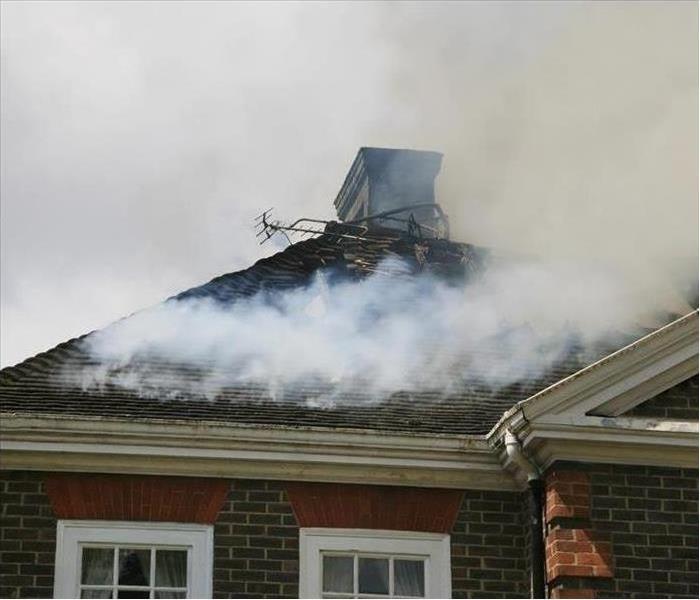 Residential fire damage in Downtown Salt Lake City, UT.
Residential fire damage in Downtown Salt Lake City, UT.
In the midst of the bustling heart of Downtown Salt Lake City, Utah, where the unexpected can happen, a beacon of hope emerges in the form of SERVPRO of Downtown Salt Lake City, led by Team Grimstead. Their dedicated professionals are experienced in tackling the challenges of residential fire cleanup, providing a comprehensive and personalized approach that helps homeowners get back on their feet. In this blog post, we will delve into the essential steps taken by Team Grimstead for residential fire cleanup in Downtown Salt Lake City.
- Immediate Response
When disaster strikes, time is of the essence. Team Grimstead, under SERVPRO, understands this fundamental truth. They operate a 24/7 emergency service, ensuring that their skilled professionals are ready to respond promptly to your call. This swift response is crucial in mitigating further damage and starting the restoration process as soon as possible.
- Detailed Assessment and Inspection
One of the key elements that set Team Grimstead apart is their thorough assessment and inspection process. Upon arrival at the fire-damaged property, their experts meticulously evaluate the extent of the damage. This comprehensive inspection allows them to create a tailored plan for cleanup and restoration. They consider factors such as soot, smoke, structural damage, and water damage to ensure no detail is overlooked.
- Securing the Property
Residential fire damage can often leave properties vulnerable to unauthorized access and further damage. Team Grimstead takes immediate measures to secure the property, boarding up windows and doors or tarping the roof to prevent any additional harm.
- Water Removal and Drying
Fires often result in water damage due to firefighting efforts. The professionals at Team Grimstead use advanced equipment to extract excess water and initiate the drying process. This critical step helps prevent the growth of mold and mildew and ensures a clean and safe living environment.
- Thorough Smoke and Soot Removal
Smoke and soot can penetrate deep into the structure of a home, leaving behind lingering odors and residue. Team Grimstead employs specialized cleaning techniques to eliminate smoke and soot from all affected surfaces, including walls, ceilings, and furniture. They also utilize air scrubbers to purify the air quality, ensuring that the space is safe to inhabit once again.
- Cleaning and Sanitizing
Cleanliness and sanitation are top priorities during the fire cleanup process. Team Grimstead goes the extra mile to ensure that all affected items and areas are thoroughly cleaned and sanitized. This includes not only visible surfaces but also hidden areas where smoke and soot may have infiltrated.
- Restoration and Reconstruction
Once the cleanup phase is complete, Team Grimstead's focus shifts to the restoration process. They collaborate with contractors and carpenters to rebuild and repair damaged structural elements, flooring, and fixtures. The ultimate goal is to return the property to its pre-fire condition, providing homeowners with a seamless transition from cleanup to restoration.
- Content Cleaning and Restoration
Team Grimstead understands the emotional attachment homeowners have to their belongings. They offer content cleaning and restoration services to salvage and restore personal items such as clothing, electronics, and sentimental possessions. Their team handles these items with care and meticulous attention to detail.
- Open Communication and Support
Throughout the entire fire cleanup and restoration process, Team Grimstead maintains open communication with homeowners, insurance companies, and other stakeholders. They provide unwavering support and guidance, ensuring that the experience is as stress-free as possible during a challenging time.
Team Grimstead, a vital part of SERVPRO of Downtown Salt Lake City, is your trusted partner in the journey to recover from residential fire damage. With their immediate response, detailed assessment, and unwavering commitment to high-quality restoration, they help homeowners regain their lives and restore their properties. When disaster strikes, remember that Team Grimstead is here to provide hope and assistance in the heart of Downtown Salt Lake City, Utah.

 24/7 Emergency Service
24/7 Emergency Service









